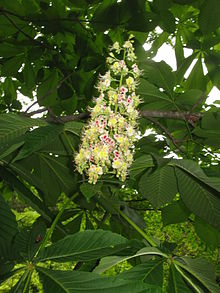| Aesculus turbinata | |
|---|---|

| |
|
Scientific classification
| |
| Kingdom: | Plantae |
| Clade: | Tracheophytes |
| Clade: | Angiosperms |
| Clade: | Eudicots |
| Clade: | Rosids |
| Order: | Sapindales |
| Family: | Sapindaceae |
| Genus: | Aesculus |
| Species: | A. turbinata
|
| Binomial name | |
| Aesculus turbinata Blume
| |
| Synonyms [1] [2] [3] | |
| |
Aesculus turbinata, common name Japanese horse-chestnut (Tochinoki or Tochi (トチノキ(栃の木) or トチ(栃、橡))), is native to Japan but cultivated elsewhere. It is a tree up to 30 m (98 ft) tall. Flowers are white to pale yellowish with red spots. Capsules are dark brown, obovoid to pyriform. [4] [1] The seeds were traditionally eaten, after leaching, by the Jōmon people of Japan over about four millennia, until 300 AD. [5] Today the seeds are used in Japanese cuisine to prepare "Tochimochi".
Etymology
Aesculus was named by Linnaeus, and the name is derived from the Roman name, aesculus, of the durmast oak. [6]
Turbinata means ‘conical’, ‘turbinate’, or ‘top-shaped’. [6]
References
- ^ a b Flora of China vol 12 page 4.
- ^ Tropicos Aesculus turbinata
- ^ Plant list Aesculus turbinata
- ^ Blume, Rumphia. 3: 195. 1847.
- ^ Harlan, Jack R. (1995). The Living Fields: Our Agricultural Heritage (1. publ. ed.). Cambridge [u.a.]: Cambridge Univ. Press. p. 15. ISBN 0-521-40112-7.Harlan cites Akazawa, T & Aikens, CM, Prehistoric Hunter-Gathers in Japan (1986), Univ. Tokyo Press; and cites Aikens, CM & Higachi, T, Prehistory of Japan (1982), NY Academic Press.
- ^ a b Gledhill, David (2008). "The Names of Plants". Cambridge University Press. ISBN 9780521866453 (hardback), ISBN 9780521685535 (paperback). p 38, 391
External links
- The Tokyo Foundation for Policy Research: Tochimochi
| Aesculus turbinata | |
|---|---|

| |
|
Scientific classification
| |
| Kingdom: | Plantae |
| Clade: | Tracheophytes |
| Clade: | Angiosperms |
| Clade: | Eudicots |
| Clade: | Rosids |
| Order: | Sapindales |
| Family: | Sapindaceae |
| Genus: | Aesculus |
| Species: | A. turbinata
|
| Binomial name | |
| Aesculus turbinata Blume
| |
| Synonyms [1] [2] [3] | |
| |
Aesculus turbinata, common name Japanese horse-chestnut (Tochinoki or Tochi (トチノキ(栃の木) or トチ(栃、橡))), is native to Japan but cultivated elsewhere. It is a tree up to 30 m (98 ft) tall. Flowers are white to pale yellowish with red spots. Capsules are dark brown, obovoid to pyriform. [4] [1] The seeds were traditionally eaten, after leaching, by the Jōmon people of Japan over about four millennia, until 300 AD. [5] Today the seeds are used in Japanese cuisine to prepare "Tochimochi".
Etymology
Aesculus was named by Linnaeus, and the name is derived from the Roman name, aesculus, of the durmast oak. [6]
Turbinata means ‘conical’, ‘turbinate’, or ‘top-shaped’. [6]
References
- ^ a b Flora of China vol 12 page 4.
- ^ Tropicos Aesculus turbinata
- ^ Plant list Aesculus turbinata
- ^ Blume, Rumphia. 3: 195. 1847.
- ^ Harlan, Jack R. (1995). The Living Fields: Our Agricultural Heritage (1. publ. ed.). Cambridge [u.a.]: Cambridge Univ. Press. p. 15. ISBN 0-521-40112-7.Harlan cites Akazawa, T & Aikens, CM, Prehistoric Hunter-Gathers in Japan (1986), Univ. Tokyo Press; and cites Aikens, CM & Higachi, T, Prehistory of Japan (1982), NY Academic Press.
- ^ a b Gledhill, David (2008). "The Names of Plants". Cambridge University Press. ISBN 9780521866453 (hardback), ISBN 9780521685535 (paperback). p 38, 391
External links
- The Tokyo Foundation for Policy Research: Tochimochi